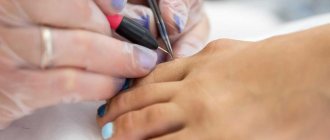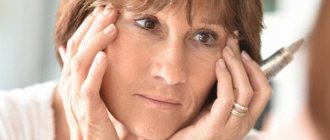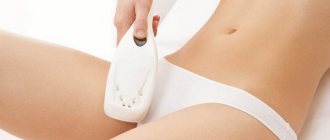Diode laser hair removal is an aesthetic medical procedure for the radical removal of unwanted hair on the face and body by completely destroying the pilosebaceous hair structures (hair follicle and sebaceous gland). The method is based on the effect of a light wave with a length of 700-800 nm, which results in heating of the melanin pigment that accumulates in epidermal cells - melanocytes. The procedure is quite comfortable for the patient, although some complain of moderate pain comparable to a mild electric shock.
Diode laser hair removal has significant advantages over other types of devices, for example, it is suitable for both dark and fair skin, and does not require the use of local anesthetics. It is not possible to get rid of unwanted body hair after one procedure: to completely destroy active and latent hair follicles, it may take up to 12 procedures, the interval between which should be at least 21 days.
Hair removal with diode laser
Features of diode laser devices
Hair removal using a diode laser is a gentle procedure, during which the risks of thermal burns and deep damage to the dermis are minimized, since the doctor has the ability to control the depth of penetration of the light flux. Unlike the pulsed alexandrite laser, whose wavelength is 755 nm, the diode laser has a different range of light waves, which allows this device to be used not only to combat unwanted vegetation on the body, but also to treat vascular pathologies (in particular, varicose veins of the legs ), as well as comprehensive skin rejuvenation.
Radical destruction of hair follicles using diode devices can be recommended for people with different skin phototypes, as well as hair of any shade (including blond hair). This type of hair removal is less painful compared to other methods of laser hair removal and does not require prior anesthesia. To reduce discomfort, apply a special cooling gel containing menthol or peppermint essential oil to the skin.
Diode laser makes hair removal almost painless
An important difference between diode hair removal and an alexandrite laser is that hairs do not “burn” under the influence of a laser beam: the light wave penetrates deep into the dermis, heats the protein pigment melanin contained in the skin and hair root, and destroys it. Since melanin, under the influence of light radiation, destroys the elements of the extracellular matrix located in the growth zone, the death of blood and lymphatic vessels, as well as the sebaceous glands of the hair, occurs. After 2-3 weeks, the destroyed root dies and the hair falls out of the hair follicle forever.
Laser device
A diode laser is used for hair removal. However, unlike photoepilation, this method is guided by a different operating principle: a narrow beam of light with a constant wavelength (808-810 nm) is directed to the desired area of the skin. This wavelength is perfectly absorbed by melanin.
The beam comes from the emitter and passes through optical materials (sapphire or quartz glass) to the skin. Sapphire glass has the best light transmittance, thermal conductivity and hardness. Quartz glasses have impurities that retain and therefore absorb light energy.
To reduce pain, the laser tip is equipped with a special cooling system. The method is contact, that is, cooling occurs by touching the skin due to the operation of Peltier elements (they are located in the diode handle). There is also a water cooling system - it works through radiators together with fans.
The whole point of cooling is to remove heat from hot parts of the equipment. To take heat from one part of the device to another, a “coolant” is used - distilled water. Being under pressure, it passes through the channels, taking heat with it, discharging it towards the radiator or fan.
Difference from mineral (Alexandrite) laser
At first glance, diode and alexandrite laser hair removal are similar procedures, but there are significant differences between them, determined by the type, functions and properties of the device used.
Procedures using diode and alexandrite lasers have their differences
Alexandrite and diode laser: differences
| Options | Diode laser | Alexandrite laser |
| Possibility of use in patients with dark skin | Yes. | No. |
| Possibility of removing light hair | Yes. | No. |
| Number of procedures per course | 8-12 procedures. | 5-8 procedures. |
| Intensity of pain during operation of the device | Weak or moderate. | Moderate to strong. |
| The need for preliminary anesthesia | Not required (cooling gel with mint oil or menthol is used to cool the skin). | Before the procedure, the skin is treated with local anesthetics containing lidocaine. |
| Possibility of removing gray hair | No. | No. |
| Interval between procedures | From 21 to 45 days. | 1.5-2 months. |
| Effective in removing dense and coarse hair | Average. | High. |
Since laser hair removal is based on heating melanin, which has a destructive effect on the components of the extracellular matrix in the hair growth zone, both types of lasers are ineffective on gray hair (there is no coloring pigment in gray hair).
Laser hair removal is ineffective for gray hair
Note! Radical destruction of the hair root along with the surrounding sebaceous glands using a diode laser device is considered a more effective procedure compared to alexandrite laser hair removal, since the device affects not only active hair follicles, but also follicles that are in a latent (“sleeping”) state . This property of the diode laser allows you to get rid of unwanted hair forever and minimize the risk of its regrowth.
Mechanism of action of a diode laser
Working principle of a diode laser
The operating principle of diode hair removal is simple: it consists in the fact that a laser beam acts on melanin, which gives color to the hair. Laser radiation is absorbed by melanin, the hair heats up, transferring the temperature through the shaft to the hair follicle, which is destroyed under the influence of high temperature.
The diode laser is effective for hair of all colors, except colorless ones. But it still produces the best effect on dark hairs, since they contain a large amount of melanin, which absorbs laser radiation. The procedure requires systematic implementation, since only then the number of hairs will decrease for a long time from a year to 1.5 years.
The laser only affects hair that is in the active growth stage; the radiation will not affect “dormant” hair follicles. That is why it is important to complete a full course of hair removal, observing the intervals prescribed by the doctor.
Indications for the procedure
Laser hair removal is a cosmetic procedure used to maintain an attractive appearance, so most often it is performed at the request of the patient without any indication. However, there are certain situations when using other methods to combat unwanted hair is not possible. Such situations include:
- allergies, hypersensitivity, poor tolerance to components included in products for hair removal at home;
- severe skin irritation after using razors, wax, sugaring paste, etc.;
- ingrown hairs, which can cause inflammation of the hair follicle;
- increased activity of hair follicles, provoking increased growth of vellus hair;
- the presence of hairs in areas of the body that are undesirable to be injured or subjected to mechanical stress (for example, above the lip);
- dark skin or skin prone to hyperpigmentation.
Diode hair removal should not be performed if there are ingrown hairs or skin irritation.
The use of diode hair removal for the treatment of hirsutism (excessive growth of terminal hair in various parts of the body) is ineffective even in mild forms of this disease. Terminal hair can appear on any part of the body; it has increased rigidity and density, as well as greater length. To get rid of such hair, hair removal with devices based on alexandrite and electrolysis (necessarily in combination with adequate hormone therapy) is more effective.
Reviews
My annual course of laser diode hair removal has ended, so I want to share my impression of this procedure, which is gaining more and more popularity. I did everything in a complex: deep bikini, armpits and legs. And after the first session I saw the result. The hairs began to grow more slowly and were soft. During the procedure itself, I did not experience any pain. It felt like I was being warmed by a sunbeam, as it was warm due to the movement of the laser. After several more sessions, the hairs began to grow less frequently. That is, if, for example, three hairs grew, then only one or two began to grow. There was no redness, inflammation or ingrown hairs. I went to sessions for a year once a month. After twelve sessions, the hair grows very slowly, its quantity has decreased significantly and it has become as soft as fluff. There are about ten hairs left to grow under my arms. Now, to maintain the results, you need to visit the center once every three months.
Anna1234321
https://otzovik.com/review_5812832.html
I decided to go with a diode laser, MeDioStar brand. I learned about him that he is supposedly one of the most modern. I found a salon in my city that works with this laser. They just had a promotion, armpits + deep bikini 5,000 rubles. The first procedure was hell for me! I was in a lot of pain and scared, because I encountered a laser for the first time. During the consultation, a cosmetologist-dermatologist examined me, explained the principle of action, the required number of procedures, at least 10 with a frequency of 30–40 days, and the wave power that would suit me. I have coarse black hair and dark skin, I really love tanning. Immediately she brought me down to earth and said miracles don’t happen! Everything is very individual, the result largely depends on the hormonal background. And even after 10 procedures, it is necessary to do maintenance procedures once every six months or a year. I am very pleased with the results, they even exceeded my expectations! There is about 15% hair left in the armpits, in the bikini area the result is a little worse, but I think this is due to the fact that the hair there is very thick. About 30 percent of the pubic hair remains. Still, I highly recommend this procedure. Everything is going exactly according to plan, as the cosmetologist promised. But, again, you need to find a good clinic and specialist. Be sure to strictly follow all recommendations and observe the frequency of procedures.
Olgaolechka
https://otzovik.com/review_6456802.html
I chose the Alexandrite laser for myself, because according to the reviews I found, it is the most effective. At the moment, I have done laser hair removal with the Alexandrite laser only 2 times. The first time was somewhere at the beginning of winter. The second is at the beginning of spring. And these two procedures were enough for me to get rid of 95% of the hair in this area. I plan to go for the third time most likely in early autumn, since I read in the summer that it is not advisable to do laser hair removal. In terms of painful sensations, of course, there is little pleasant. The laser hair removal procedure reminds me of small burns. It’s as if a hot object is brought to the skin and it burns a little. But the pain goes away quickly. Am I satisfied with the effect? Yes, 100% sure. The fact is that the master told me that most likely I would need about 4 procedures to completely get rid of hair in this particular area. And in others up to 10 times. As it turned out, the effect even after 2 procedures was very pleasant for me.
https://irecommend.ru/content/2-raza-i-net-volos-ya-dumala-tak-ne-byvaet-kak-lazernaya-epilyatsiya-aleksandritovym-lazerom
I did laser hair removal, but not with a diode, but with an alexandrite laser... lower legs 12 times, still a third or a quarter of the hair remained, 6 sessions above the lip, it felt like all the hair remained (((But in general, they say that it all depends on hair color and structure.
Charmer
https://deti.mail.ru/forum/zdorove/zdorove_krasota_diety/lazernaja_jepiljacija_diodnym_lazerom_kto_delal/?page=3
Advantages of the method
The diode technique for combating unnecessary vegetation is one of the most popular cosmetic procedures, as it has significant advantages over other methods of combating body hair. One of them is the ability to regulate the power and length of the light flux, which allows this device to be used on any skin type, including skin prone to hyperpigmentation. A significant advantage of diode hair removal is its high degree of safety, since during radiation there is no damage to epidermal cells, which completely eliminates the risk of thermal burns and irritations. The absence of mechanical impact on the tissues surrounding the hair follicle also reduces the risk of inflammatory processes and skin infections.
The use of a diode laser is an absolutely safe procedure
Other important advantages of diode laser hair removal include:
- no significant side effects. If the execution technique is followed, the power and length of the light flux are correctly selected, side effects are minimal and mildly expressed;
- short recovery period. Immediately after hair removal, the skin may look hyperemic (extremely slightly swollen), but these symptoms completely disappear within 1-2 days;
- the possibility of performing the procedure on people with dark skin color. A history of a recent tan is a contraindication for almost all laser procedures, but a diode laser can also be used for this type of skin (which does not exclude possible side effects in the form of hyperpigmentation and premature aging of the skin associated with excess light energy entering the dermal cells);
- short duration of the procedure. Hair removal with a diode laser takes literally 10-20 minutes, while at one time the specialist has the ability to treat fairly large areas of the body.
After the procedure, slight redness may be observed on the skin
Diode hair removal is less painful compared to other methods of radical hair removal, which can also be considered its advantage. To reduce pain during the procedure, cooling preparations are used in the form of a balm or gel, and additional cooling is provided during operation of the device itself by a flow of cold air.
Some general preparation tips
It is recommended to carry out a preparatory procedure before the first session. Laser exposure on a small area of skin will allow you to understand how painful the procedure is for the client, and will also help him understand what the technique is all about and dispel fears. It is also very important to exclude all contraindications. Therefore, it is best to consult a doctor, and only then go for laser hair removal if there are no diseases.
Preparation for laser hair removal according to all the rules is the key to the effectiveness of the session and achieving an ideal result without unpleasant consequences. In addition, it is important to prepare high-quality equipment for removing unwanted hair. You can purchase a certified laser device from the Medicalaser store. We have been producing cosmetology equipment for more than 10 years, which was appreciated by professionals not only in Russia, but also in all nearby countries. The range includes high-quality diode lasers and multifunctional devices.
Description of the procedure: technique and preparation
The diode laser hair removal procedure can be performed in a beauty salon, having previously consulted with a cosmetologist about existing contraindications and the desired effect. Patients with a history of chronic diseases are also recommended to obtain a physician’s opinion, since in some cases (for example, with oncological pathologies) any procedures using lasers may be contraindicated.
If you have chronic diseases, you need to consult a therapist
At the initial consultation, the doctor will examine the problem area, determine the hair type, its hardness and density, and give recommendations for preparation.
Preparation
There is usually about 10 days between the initial examination and the procedure. If the patient has not visited a solarium or sunbathed, the procedure can be done on the day of treatment or the next day. Despite the fact that dark and tanned skin is not a contraindication for diode hair removal, with a fresh tan it is better to maintain a ten-day interval, since excessive light rays may be one of the reasons for increased pigmentation and premature photoaging.
A day before epilation (possibly on the day of the procedure), it is necessary to remove hair from the treated area using a razor. 30 days before the procedure, it is prohibited to use any products that can injure the hair follicle: scrubs, sugaring pastes, electric epilators, wax strips, etc.
Waxing, like other methods of hair removal, should be abandoned a month before the procedure.
If hair removal is to be performed on the face, on the day of hair removal you should completely avoid using cosmetics, and 30-40 minutes before the procedure, clean the skin of dirt and excess sebum using alcohol-free wipes or a soft cleansing mousse.
In the office
The duration of laser exposure depends on the area of the treated area and the stiffness of the hair growing on it, but, as a rule, it does not exceed 20 minutes. Before turning on the device, the doctor puts on protective glasses for himself and the patient, which cannot be removed throughout the procedure, as they prevent damage to the cornea and retina.
You must wear glasses during laser hair removal.
The operation of the device resembles short flashes (1 flash for each microzone). The procedure may be uncomfortable for the patient, but pain usually does not appear. The sensations described by people who have undergone diode laser hair removal can be compared to a slight tingling and tingling sensation, and hair removal in the armpit area usually only causes a feeling of diffuse warmth at the site of treatment. The smell of burnt hair and pain can be minimized due to the cooling system provided by the sapphire nozzle.
How many sessions do I need to complete?
One procedure is not enough to have a radical effect on the pilosebation elements, but even after the first session you can notice that there is significantly less hair, and the newly growing hairs have a lighter color and softer structure. Such hairs between sessions must be removed using a razor or a special depilatory cream (in no case should you use products that can injure the hair follicles and hair roots).
Between sessions, growing hairs should be removed using depilatory cream.
In order for the result to be as effective as possible (from 90% to 100% of getting rid of unnecessary hair) and to last for a long time, you will need to complete a course of 5-12 procedures. The interval between sessions should be from 21 days (for the face, bikini, intergluteal fold and armpits) to 4-6 weeks (for other areas of the body).
After hair removal
Immediately after the procedure, the cosmetologist applies a gel or balm with a wound-healing, regenerating, anti-inflammatory, soothing and bactericidal effect to the treated area. This measure will not only reduce the risk of irritation and soothe the skin after thermal exposure, but also improve the process of cellular regeneration. At home, you can repeat the treatment after 3-4 hours, using products that contain panthenol (“Dexpanthenol”, “Bepanten”, “D-Panthenol”).
Ointment "Dexpanthenol"
Preliminary preparation for laser hair removal
Before starting the procedure, you should prepare responsibly, as this will affect the result of the work.
If you plucked your hair less than a day before the session, then it is prohibited. It is recommended to shave the hairs with a simple razor two days before the procedure, since by the beginning of the session the hairs will have the required length, and the irritation after the razor will already subside. The most effective hair length is considered to be one millimeter; in this situation, root destruction will be the most effective, since heating the hair will take less time and energy. If the hairs are too long, then all the laser energy will be spent only on heating the rod, and the follicle will remain untouched.
In addition, on the day when the session is scheduled, it is recommended to refrain from using creams or other cosmetics. Since some of them are capable of forming films that interfere with the procedure, and some creams can cause skin burns.
How to avoid side effects: advice from cosmetologists
After the procedure, the patient must also follow certain recommendations.
- Visiting the steam room, bathhouse, sauna, as well as taking a hot shower and bath is prohibited within 72 hours from the moment of hair removal.
- To prevent hyperpigmentation, it is not recommended to sunbathe or be exposed to open sunlight for 10 days. If you need to go outside, a protective agent with a protection level of at least SPF 30+ should be applied to the part of the body being treated (for dark skin - SPF 40+).
- It is unacceptable to use cosmetics and hygiene products that contain ethyl alcohol (in any concentration) for 1 month.
After laser hair removal, you should not take a hot bath for several days.
Patients are also advised to avoid using epilators, tweezers and other products that can injure the skin and structure of hair follicles.
Recovery period
After the diode laser hair removal procedure, it is important to also know the basic rules of skin care so that the recovery period goes much faster and without consequences.
How to care for your skin after exposure to a diode laser?
- For three weeks, you should avoid exposure to ultraviolet radiation on the laser-treated area (this applies to both tanning in the sun and in a solarium)
- For a while, you should avoid scrubs with harsh abrasive particles, which can disrupt the integrity of an already affected area of the skin.
- If the skin where hairs were removed by laser turns red, you can treat it with baby or light moisturizer
- refrain from heavy physical activity
What restrictions might there be?
Radical hair removal on the body with a diode laser is a fairly safe procedure, but it also has certain contraindications that cannot be ignored so as not to harm your health. The procedure is prohibited if there is a history of the following pathologies:
- malignant tumors of any location;
- inflammatory skin diseases in the acute stage;
- mental disorders (schizophrenia, epilepsy);
- any neoplasms at the site of intended exposure;
- herpetic rashes;
- severe decompensated endocrinological disorders (in particular, diabetes mellitus);
- pathologies of the vascular system (varicose veins);
- installed pacemaker;
- diseases of the hematopoietic system.
For varicose veins, diode laser hair removal is contraindicated.
Diode laser hair removal is contraindicated for pregnant and lactating women, patients under the influence of alcohol and drugs, as well as persons receiving hormonal therapy. If the patient has a fresh tan on the body, it is recommended to maintain an interval of at least 10 days.
Who is contraindicated for laser hair removal?
Only a cosmetologist at our salon will tell you whether you can have hair removal or not during a preliminary consultation. We provide a list of the most common contraindications:
- psoriasis and other skin lesions;
- pregnancy and lactation;
- infectious skin diseases;
- oncological diseases;
- diabetes;
- taking tetracycline antibiotics and steroids.
Before carrying out the procedure, you should consult with a specialist. He will be able to determine whether laser hair removal is possible in each specific case, and will also make a forecast of the number of procedures (their number may differ for each individual patient).
Why did I choose laser hair removal?
Photos before and after
Photos before and after hair removal with diode laser No. 1
Photos before and after hair removal with diode laser No. 2
Photos before and after hair removal with diode laser No. 3









